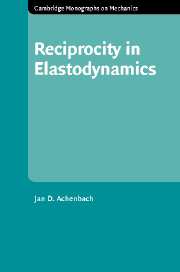Book contents
- Frontmatter
- Contents
- Preface
- 1 Introduction
- 2 Some elastodynamic theory
- 3 Wave motion in an unbounded elastic solid
- 4 Reciprocity in acoustics
- 5 Reciprocity in one-dimensional elastodynamics
- 6 Reciprocity in two- and three-dimensional elastodynamics
- 7 Wave motion guided by a carrier wave
- 8 Computation of surface waves by reciprocity considerations
- 9 Reciprocity considerations for an elastic layer
- 10 Forced motion of an elastic layer
- 11 Integral representations and integral equations
- 12 Scattering in waveguides and bounded bodies
- 13 Reciprocity for coupled acousto-elastic systems
- 14 Reciprocity for piezoelectric systems
- References
- Index of cited names
- Subject index
4 - Reciprocity in acoustics
Published online by Cambridge University Press: 10 December 2009
- Frontmatter
- Contents
- Preface
- 1 Introduction
- 2 Some elastodynamic theory
- 3 Wave motion in an unbounded elastic solid
- 4 Reciprocity in acoustics
- 5 Reciprocity in one-dimensional elastodynamics
- 6 Reciprocity in two- and three-dimensional elastodynamics
- 7 Wave motion guided by a carrier wave
- 8 Computation of surface waves by reciprocity considerations
- 9 Reciprocity considerations for an elastic layer
- 10 Forced motion of an elastic layer
- 11 Integral representations and integral equations
- 12 Scattering in waveguides and bounded bodies
- 13 Reciprocity for coupled acousto-elastic systems
- 14 Reciprocity for piezoelectric systems
- References
- Index of cited names
- Subject index
Summary
Introduction
The first reciprocity relation specifically for acoustics was stated by von Helmholtz (1859). This relation caught the attention of and was elaborated by Rayleigh (1873) and Lamb (1888). Rayleigh (1873) briefly discussed the reciprocal theorem for acoustics in his paper “Some general theorems relating to vibrations.” In The Theory of Sound (1878, Dover reprint 1945, Vol. II, pp. 145–8), Rayleigh paraphrased this theorem as follows: “If in a space filled with air which is partly bounded by finitely extended fixed bodies and is partly unbounded, sound waves may be excited at any point A, the resulting velocity potential at a second point B is the same both in magnitude and phase, as it would have been at A, had B been the source of sound.” In this statement it is implicitly assumed that sources of the same strength would be applied at both places. In Rayleigh's book (1878) the statement is accompanied by a simple proof. A similar statement of the Helmholtz reciprocity theorem for acoustics can be found in the paper by Lamb (1888). Both Rayleigh and Lamb generalized the theorem to more complicated configurations, and in time the reciprocity theorem became known as Rayleigh's reciprocity theorem.
Most books on acoustics devote attention to the reciprocity theorem; see for example Pierce (1981), Morse and Ingard (1968), Jones (1986), Dowling and Ffowcs Williams (1983) and Crighton et al. (1992). A book by Fokkema and van den Berg (1993) is exclusively concerned with acoustic reciprocity.
- Type
- Chapter
- Information
- Reciprocity in Elastodynamics , pp. 55 - 69Publisher: Cambridge University PressPrint publication year: 2004

